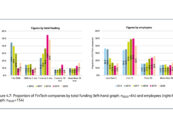Corporate payments constitute a significant share of the revenue-pie in corporate banking. But banks have struggled with challenges of slow and sluggish reconciliation due to batch processing and lack of straight-through processing in this crucial line-of-business for a long time.
Digitization is bringing in renewed agility and flexibility, and banks can now unlock revenue and multifold efficiency gains for their business clients. In this short blog post, we look at five ways how:
- 1. Payment hub
Payment hubs are an efficient way for banks grappling with challenges of inordinately high cycle times due to single aggregator payment systems that interface with other disparate systems such as treasury and wealth management. A centralized payment hub connected to various transaction systems can facilitate consolidated payment flows online and help banks drive significantly faster reconciliation than traditional stand-alone systems that run periodic batch programs.
- 2. ERP integration
What augments the efficiencies of a payment hub is straight-through-processing. Integrating the payment hub with corporate ERP solutions allows end-to-end integrated workflows for significant efficiency gains by elimination of manual paper-based reconciliation of payables and receivables.
- 3. API-led payments
API-led ecosystem-driven banking demands capabilities that allow free movement of data and access to functionalities not only within the bank, but also with systems outside the bank. The traditional aggregator systems require all external systems to interface with a single payment system of a given bank. Modern customer-centric payment systems can drive convenient and faster customer transactions through interactions on different interfaces.
- 4. Blockchain-based payments
Blockchain’s benefits of real-time immutable transactions have been recognized across industries, and the technology is finding wide application in banking too. Blockchain-based payments not only help banks eliminate manual paper-based processes but also serve to reduce fraud and probability of exposure to data records.
Cross-border remittance is one of the first areas to be transformed using the technology, with serval banks adopting the technology for remittance transactions. Emirates NBD and ICICI Bank’s blockchain network on the UAE-India payments corridor, one of the busiest corridors in the world, has helped the banks achieve about 70% reduction in reconciliation costs.
- 5. Digital solutions for anti-money laundering
Banks are adopting sophisticated AI-based engines to automate analysis of huge volumes of transaction data and reduce incidents of fraud. AI algorithms can recognize potentially fraudulent activity in real-time and also continuously learn about risk indicators, unusual behavior, and mitigation strategies to contain and arrest fraud at minimum cost. What’s more, AI-led AML solutions can help banks meet regulatory compliance more effectively and at low cost.
Having said that, banks must exercise caution to ensure the data and practices used to train AI are accurate and governed stringently.
Infosys Finacle recommends banks to take a holistic look at the above solutions to realize benefits across customer experience, cost efficiency, risk management and revenue enhancement.
The Payment Product module of Infosys Finacle’s Corporate Banking Suite provides banks the infrastructure to configure and bundle products for their business clients. The solutions support high parameterization and allows banks to create multiple products and align them to groups of accounts. Some of the leading banks such as Bank of the West in the US and QNB in Africa have implemented Finacle’s payments hub as part of their overall modernization projects.
Featured image credit: freepik.com






